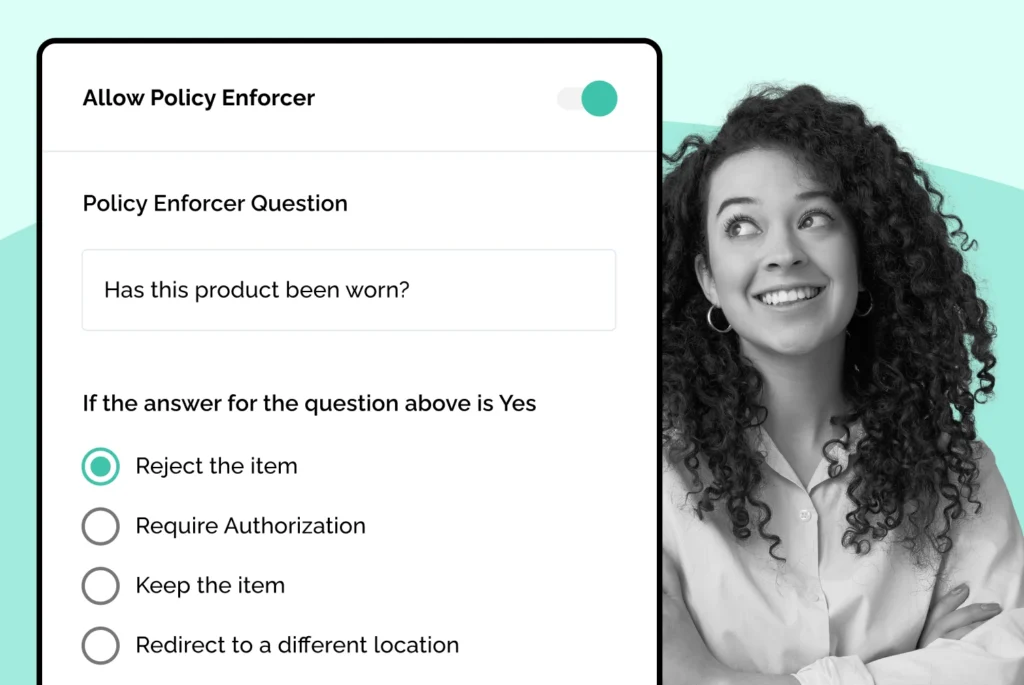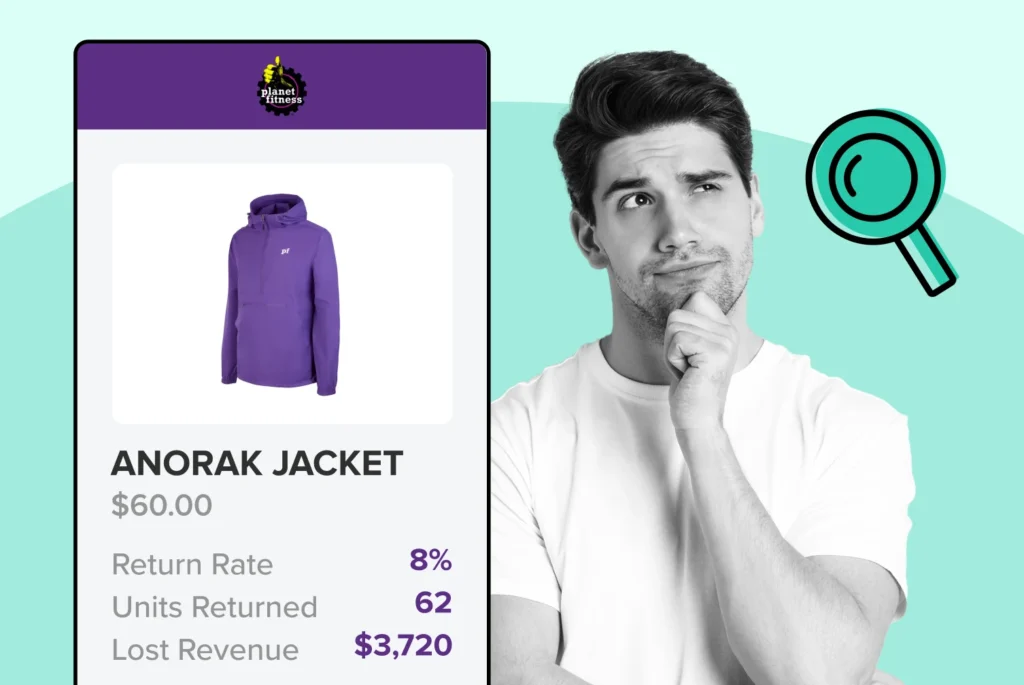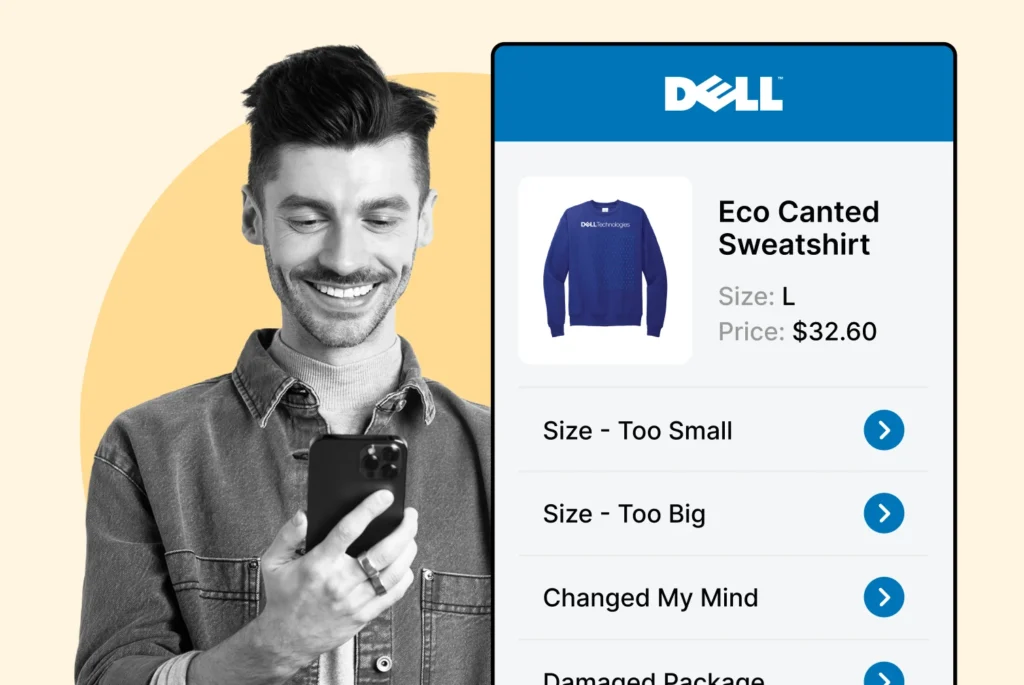
Top Strategies to Prevent Return Fraud to Safeguard Your Bottom Line
Targeted actions to help you minimize the risk of fraudulent returns and keep your revenue intact without compromising customer experience!
Boost customer experience and reduce support tickets
Realtime order and shipment tracking
Proactive order and shipping notifications
Predictive pre-purchase estimated delivery dates
Self-Serivce branded order tracking
Effortless experience delivered
Make returns profitable and delight customers
Flexibility to define any return destinations & conditions
Simplify returns for your customers and team
Incentivize exchanges over returns
Returns management made easy for your team
Understand why your customers are returning
Unify the online and the in-store experience
Hassle-free pickup experience for customers
In-Store Dashboard to keep operations streamlined
In-Store and Online orders unified
Drive foot-traffic to your stores
Boost customer experience and reduce support tickets
Realtime order and shipment tracking
Proactive order and shipping notifications
Predictive pre-purchase estimated delivery dates
Self-Serivce branded order tracking
Effortless experience delivered
Make returns profitable and delight customers
Flexibility to define any return destinations & conditions
Simplify returns for your customers and team
Incentivize exchanges over returns
Returns management made easy for your team
Understand why your customers are returning
Unify the online and the in-store experience
Hassle-free pickup experience for customers
In-Store Dashboard to keep operations streamlined
In-Store and Online orders unified
Drive foot-traffic to your stores
Find the answer to all your questions
Explore the most comon questions about WeSupply
Calculate the ROI that WeSupply can bring you
Request a no strings attached review of your current shopping experience and missed conversion opportunities
Take a step by step trip through our functionality to see how we can improve your ecommerce processes.
Read actionable articles on how to optimize your post-purchase experience and decrease support tickets
Get inspired by stories of how our customers implemented an effortless post-purchase experience
A Deep Dive into Top Companies' Order Tracking & Returns Strategy
Wondering if WeSupply is a good fit for you? Read through our use cases to see how we can help you increase conversion & improve CX!

Return fraud can drain your business’s resources. To stop this, we present you with strategies and essential steps to combat return fraud. You’ll learn how to strengthen policies, utilize new tech, and train staff effectively—all aimed at protecting your bottom line. Get ready to turn the tables on return fraud.
To combat return fraud, retailers must understand its various types, including receipt fraud, wardrobing, and friendly fraud, then develop prevention strategies accordingly.
Implementing a clear and comprehensive return policy, a strong verification process, and leveraging technology such as data analysis and machine learning can effectively deter return fraud.
Retailers should provide thorough employee training, monitor return patterns to identify fraud, collaborate with industry partners, adjust policies during peak seasons, and maintain ethical treatment of customers.
WeSupply streamlines returns management and combats fraud, boosting both profitability and customer satisfaction. Its integrated return policies on the order lookup page optimize revenue by discouraging refunds and offering free exchanges. Advanced fraud detection technologies and detailed analytics help identify problematic return patterns and refine product offerings. This approach is especially effective during peak seasons with policies like no returns on sale items and restocking fees. Ready to enhance your returns process? Get started with WeSupply today.
Return fraud is a growing concern, with the costs associated with it rising every year. It’s not just the direct financial loss due to fraudulent returns; retailers also bear the costs associated with restocking, repackaging, and reselling returned items. Not to mention the lost sales opportunities when return fraud occurs and items can no longer be sold at full price. Implementing return fraud detection is crucial for retailers to effectively identify signs of fraudulent returns and mitigate these risks.
Maintaining profitability and customer satisfaction relies heavily on the detection and prevention of return fraud. Effective return fraud prevention can help protect your business from significant financial losses, maintain your reputation, and ensure that your customers have a positive shopping experience.
The initial step in developing effective prevention strategies involves comprehending the various types of return fraud, including refund fraud. One common type is receipt fraud, where fraudsters use counterfeit or stolen receipts to return stolen or counterfeit items for a full refund. For instance, a fraudster may buy an item on sale and then use a counterfeit receipt showing the full price to return it, turning a profit in the process.
Another prevalent type is wardrobing, where customers purchase products with the intent to use them once and then return them, essentially treating them like stolen merchandise. For example, someone might buy a high-end designer dress, wear it to a special event, and then return it the next day, claiming it was never used.
Then there’s friendly fraud, where customers make a legitimate purchase but then file a fraudulent chargeback with their credit card company, claiming the item was never delivered or even reporting a stolen credit card. This puts the retailer in a difficult position as they are left to dispute the chargeback, often without success.
To combat return fraud, retailers can effectively utilize a robust return policy as a tool. It’s important to establish a clear and comprehensive return policy that outlines the conditions under which returns are accepted, the timeframe for returns, and the form of refund provided (e.g., cash, store credit, exchange). For instance, limiting the return period to 14 days can discourage wardrobing, while requiring a receipt for all returns can help prevent receipt fraud.
Furthermore, effective communication of your return policy to customers is of utmost importance. This includes displaying it prominently in-store and online, including it in sales receipts, and training employees to explain it to customers at the point of sale. Clear communication not only helps deter fraudsters but also ensures genuine customers understand their rights and responsibilities when it comes to returns.
WeSupply can assist in developing a robust return policy that enhances customer experience and optimizes revenue retention. Here’s how:
Discourage Refunds: Charge an additional processing fee for refunds to promote exchanges or store credit, maintaining more revenue.
Free Returns on Exchanges: Increase customer loyalty and satisfaction by offering free return shipping on exchanges.
Specific Non-Returnable Products: Improve inventory management by specifying certain SKUs that cannot be returned.
Variable Shipping Fees: Charge for return shipping based on the reason for the return, effectively balancing costs with customer service.
Restrictions on Sale Items: Enforce a no-return policy on sale items to protect profits while managing customer expectations.
One more example of WeSupply’s Pre-Built Policies tailored for minimizing fraud is the Blocklist feature. This policy allows businesses to blocklist specific email addresses or customer groups, effectively preventing fraudulent customers from returning products. By implementing a strategic blocklist system, companies can target and mitigate fraudulent behavior, thereby safeguarding their interests and revenue. The importance of this approach cannot be overstated, as a smart return policy paired with a blocklist system not only increases customer loyalty but also reduces return abuse and maintains profitability. Without such measures, businesses risk continued abuse, lost revenue, and a tarnished brand reputation.
With WeSupply, streamline your returns process, enhance customer satisfaction, and safeguard your margins effectively. Ready to see how? Book a demo today and revolutionize your return policy.
Return fraud prevention heavily relies on the verification process. Requiring proof of purchase, such as a receipt or invoice, can significantly reduce instances of receipt fraud. Incorporating identity verification measures, such as matching the customer’s ID with the name on the credit card used for the purchase, can further bolster your defense against fraud.
A robust verification process can deter fraudsters, as it increases the likelihood of their fraudulent activities being detected. However, implementing this process in a manner that doesn’t inconvenience genuine customers is paramount. After all, maintaining a positive customer experience is just as important as fraud prevention.
The evolution of technology brings with it the advancement of tools and techniques for combating return fraud. Some of these tools and techniques include:
Data analysis, which can be incredibly valuable for detecting fraud patterns
Machine learning algorithms, which can analyze return patterns and identify anomalies that may indicate fraudulent activity
Predictive modeling, which can predict the likelihood of a return being fraudulent based on historical data
These anti fraud tools and techniques can help businesses better detect return fraud, prevent return fraud, and address return abuse.
Technologies such as digital receipts and customer accounts can also aid in return fraud prevention. Digital receipts can be used to track transactions, verify returns, and deter receipt fraud, while customer accounts can provide a wealth of information about purchase history, return behavior, and more.
Moreover, integrated point-of-sale systems and return management systems offer a comprehensive approach to managing returns. These systems can track return patterns, flag suspicious activities, and even automate the return process, making it easier for retailers to detect and prevent fraud.
In addition to these technologies, retailers can also leverage social media lookup tools to verify the identity of customers and deter fraud. For example, if a customer is returning high-value items frequently, a quick social media lookup may reveal whether their behavior is consistent with their online persona or if they may be a potential fraudster.
WeSupply offers advanced technology solutions to effectively combat return fraud, ensuring that your business maintains integrity and profitability. Here’s how:
Block List Integration: Sync and enforce an existing block list of customers to prevent fraudulent returns, with options for manual review.
Customizable Detection Rules: Easily configure the criteria for detecting fraudulent activities and decide on the subsequent actions.
Return Analytics: Gain insights through detailed returns analytics to understand patterns, identify serial returners, and reduce overall return rates.
If your eCommerce store is running on the Magento 2 platform, you can check out the awesome WeltPixel MaxMind Fraud Prevention extension, which is designed specifically to bring MaxMind’s (one of the leading Fraud Prevention services in the eCommerce space) services over to the Magento 2 platform. The extension is officially endorsed by MaxMind and is one of the most powerful available on the market!
Returns Analytics for eCommerce Business
Understand why your customers are returning: Identify the most returned products, Understand why those products are returned, Identify which customers are serial returners, Reduce Return Rate with Actionable Insights.
Employees are often the first line of defense against return fraud. Training them to recognize signs of fraudulent returns and empowering them to act on suspicious activities can significantly strengthen your defense against return fraud. For instance, employees should be trained to look out for common signs of fraud, such as returns without receipts, frequent returns by the same customer, and returns of high-value or high-risk items.
Having robust procedures in place for handling suspected fraudulent returns is also crucial. Employees should know when and how to escalate suspicious activities, and there should be clear guidelines on how to handle such situations. This can include denying the return, conducting further verification, or even reporting the incident to law enforcement.
Another effective strategy for detecting and preventing return fraud is the monitoring and analysis of return patterns. By keeping a close eye on return trends, retailers can identify patterns that may indicate fraudulent activity. Some examples of return patterns to watch out for include:
A sudden spike in returns of a particular item
Frequent returns by the same customer
Returns made without a receipt or proof of purchase
Returns made after the return window has expired
Returns of high-value items
If any of these patterns are detected, it could signal potential fraud and further investigation may be necessary.
Based on this analysis, retailers can identify high-risk products and customers and adjust their return policies accordingly. For example, if certain items are frequently returned and suspected to be subject to wardrobing, retailers might consider shortening the return period for these items or implementing a restocking fee to deter fraudulent returns.
WeSupply empowers your business to monitor and analyze return patterns effectively, enabling you to refine your product offerings and enhance customer satisfaction. Here’s how it helps:
Deep Insights into Return Reasons: Understand why specific products are frequently returned and address underlying issues.
Identification of Serial Returners: Pinpoint customers who frequently return items and tailor your strategies accordingly.
Actionable Insights: Leverage detailed analytics to reduce return rates and improve your business operations.
With WeSupply, gain the insights needed to minimize returns and improve your customer experience. Curious to learn more? Book a demo today and take the first step towards optimizing your return process.
Fraud prevention extends beyond the responsibility of individual retailers; it necessitates a collective effort. Collaborating with industry partners, retail associations, and law enforcement can enhance fraud prevention efforts. Some ways to collaborate include:
Sharing information about known fraudsters and scams
Participating in industry-wide initiatives and sharing best practices
Working together to develop new technologies and strategies to combat fraud
By working together, businesses can stay alert and prepared to prevent fraud.
Moreover, reporting suspected fraud collectively can send a strong message to fraudsters that their actions will not be tolerated. By working together and following guidelines provided by organizations like the National Retail Federation, retailers can create a safer and more secure retail environment, protecting their businesses and customers from the detrimental effects of return fraud.
Offering store credits or gift cards in place of cash refunds is an effective strategy to reduce return fraud. By encouraging customers to choose these alternatives, businesses can deter cash-driven, opportunistic returns and instead foster repeat purchases. Store credits and gift cards not only create an incentive for customers to remain loyal, but they also diminish the appeal of fraudulent returns, where the primary motivation is quick cash. This approach helps businesses safeguard revenue while simultaneously promoting ongoing customer engagement.
WeSupply empowers businesses to minimize return fraud and enhance customer loyalty by offering store credits or gift cards instead of cash refunds. This approach not only encourages repeat purchases but also helps retain revenue while discouraging fraud-driven returns. Key features include:
Incentivize exchanges over returns to save sales and boost average order value with instant store credit.
Reward customers who choose instant store credit over cash refunds, creating a more loyal customer base.
Redirect customers to your product catalog after initiating a return, encouraging them to explore more products.
Enforcing time limits on returns is a powerful way to curb various types of return fraud while maintaining flexibility for genuine customers. By restricting the return period to a specific timeframe, such as 2-4 weeks, businesses can prevent issues like competitor sabotage, where items may be returned long after they are purchased. This approach allows ample time for legitimate customers to return items if they encounter issues, while minimizing the opportunity for fraudulent returns. Customizing the return window based on product type can further balance fraud prevention with customer satisfaction.
WeSupply simplifies managing return time limits, reducing fraud while enhancing customer experience through clear and customizable return windows. This feature allows businesses to enforce specific timeframes for returns, minimizing confusion and preventing unauthorized returns. Key features include:
Confusion-free return windows that clearly define the start of a return period, whether it’s based on order date, fulfillment date, or delivery date.
Holiday-specific return windows to accommodate seasonal flexibility.
Product-specific return windows based on SKU, type, or tag for targeted control.
Brand/vendor-specific return windows, allowing businesses to respect individual brand policies and create a consistent customer experience across different platforms.
These pre-built policies help ensure returns are straightforward and aligned with business needs, reducing fraud risk and maintaining customer trust.
Peak retail seasons, such as the holiday season, can present unique challenges when it comes to return fraud. During these high-risk periods, retailers may need to modify their return policies to protect against increased fraud attempts. Some strategies to consider include:
Shortening the return period
Requiring stricter proof of purchase
Implementing a restocking fee
Limiting the types of items that can be returned
Increasing staff training on identifying fraudulent returns
By implementing these measures, retailers can help mitigate the risk of return fraud during peak retail seasons.
WeSupply’s pre-built return policies are expertly designed to handle special considerations during peak seasons, ensuring that your business remains efficient and customer-friendly even during the busiest times. Here’s how these policies can help:
In the case of EVEREVE, the shift towards online shopping during the COVID-19 pandemic led to a sharp increase in return rates, a challenge exacerbated by the high return rates typical in the apparel industry. To tackle this, EVEREVE overhauled its returns management by implementing WeSupply’s integrations with Magento, Zendesk, Celerant, and Veeqo. This strategic change focused on proactivity, self-service, and return flexibility. With automated returns and a unified management interface, EVEREVE not only improved operational efficiency but also enhanced customer satisfaction through easier self-service options. This resulted in cost savings, quicker and more accurate returns processing, and a more streamlined customer experience. The proactive approach helped minimize additional shipping costs and reduce manual handling by optimizing return routes from the start, turning a logistical challenge into a new opportunity for customer engagement and retention. Curious about the detailed transformation? Read the full case study on EVEREVE’s innovative approach to returns management with WeSupply.
The need to employ aggressive tactics to prevent return fraud should be balanced with the ethical treatment of customers. After all, the majority of customers are honest and should not be inconvenienced or penalized due to the actions of a few fraudsters. For instance, a customer making a legitimate return should not have to undergo an overly rigorous verification process.
Additionally, understanding the legal implications of their return policies and fraud prevention measures is a necessity for retailers. For example, certain practices, such as denying returns without a valid reason or imposing unreasonable conditions for returns, may violate consumer protection laws.
To sum up, a comprehensive approach for preventing return fraud includes:
Understanding various types of fraud
Developing a robust return policy
Leveraging technology
Training employees
Collaborating with industry partners
By employing these strategies, retailers can protect their businesses from the significant financial losses associated with return fraud, while still maintaining a positive customer experience and fostering customer loyalty.
Looking ahead, the future of fraud prevention lies in the continued advancement of technology and the cultivation of a culture of transparency and integrity in managing retail returns. As retailers continue to navigate the challenges of return fraud, they must remain adaptable, proactive, and committed to maintaining a balance that protects against vulnerabilities without damaging the customer experience.
In this post, we’ve delved into the world of return fraud, exploring its various types, its impact on the retail industry, and effective strategies for detection and prevention. We’ve highlighted the importance of a robust return policy, employee training, and the use of technology in combating return fraud. We’ve also stressed the need for collaboration among retailers and the importance of balancing fraud prevention measures with ethical customer treatment.
WeSupply offers a streamlined approach to manage returns and combat fraud, enhancing both profitability and customer satisfaction. By integrating robust return policies directly on the order lookup page, it optimizes revenue retention through measures like charging processing fees for refunds and offering free returns on exchanges. WeSupply also utilizes advanced technology for fraud detection, including automated detection, block list integration, and customizable rules. Plus, detailed returns analytics help you understand return patterns, identify frequent returners, and refine product offerings. This comprehensive system is especially effective during peak seasons with policies like no returns on sale items and restocking fees. Ready to streamline your returns process? Get started with WeSupply today and transform your returns management.
Combat inconvenience with proactivity & self service
Book a quick call with our experts to see how WeSupply can help you make returns easy for your customers with a beautiful, self-service solution that makes their experience easier while also providing new ways to lower costs and earn back revenue.
Return fraud is the act of defrauding a retailer through product returns, causing significant financial losses and operational difficulties for retailers worldwide.
Some common types of return fraud are receipt fraud, wardrobing, and friendly fraud. Customers may use counterfeit receipts, buy products with the intent to return them after use, or file fraudulent chargebacks with their credit card company.
Technology can combat return fraud by using data analysis and machine learning to detect fraud patterns, utilizing digital receipts and customer accounts to verify returns, and implementing integrated point-of-sale systems and return management systems to track return patterns and automate the return process. This helps in reducing fraudulent returns and protecting businesses from losses.
During peak retail seasons, it’s important for retailers to modify return policies to guard against increased fraud attempts. This might involve shortening the return period and requiring stricter proof of purchase to mitigate risks.
It’s essential to balance aggressive return fraud prevention tactics with ethical treatment of customers and be aware of the legal implications to avoid violating consumer protection laws. Be mindful of these considerations to maintain a fair and lawful approach.
WeSupply implements a policy where additional processing fees are charged for refunds. This encourages customers to opt for exchanges or store credit, thus retaining more revenue for the business.
WeSupply employs advanced fraud detection technology that automatically identifies customers who might be abusing the return policy. It also allows integration with existing block lists to prevent known abusers from making returns, further safeguarding business integrity.
WeSupply offers detailed returns analytics that enable businesses to identify the most returned products, the reasons behind these returns, and customers who are serial returners. This data helps businesses make informed decisions to reduce return rates.
Yes, WeSupply does have an official Shopify App. You can download and begin to integrate it with your Shopify store.
Yes, WeSupply has an official extension for Magento. The WeSupply x Magento integration allows for automating order tracking experiences, reducing customer inquiries, automating shipping email and SMS notifications, and providing a fully branded order tracking experience
Yes, WeSupply has an official BigCommerce App. You can integrate WeSupply with your BigCommerce store to improve your post-purchase customer experience.
Learn How To Create Successful Post Purchase Email Campaigns
Build an effective post-purchase email flow that helps you increase customer satisfaction and drive revenue growth!

Targeted actions to help you minimize the risk of fraudulent returns and keep your revenue intact without compromising customer experience!

Discern between fraudulent and legitimate returns & enforce preventive measures effectively: a realistic approach to preventing return fraud.

Explore crucial data that will directly inform your strategy and operations: return rate, average return value, and customer refund patterns!

Let’s dive into innovative approaches that equip you with actionable insights on harnessing the full potential of returns data!

How you can leverage the different return metrics to fine-tune your business strategy and drive sustainable growth!

Concrete strategies for preventing ecommerce return fraud: from strengthening your return policy to leveraging technology and analytics!

Practical strategies and real-world applications to turn your returns into a powerful operational efficiency and customer satisfaction tool!

Let’s explore the tangible impact of retail analytics, revealing how it informs strategies, optimizes operations, and predicts market trends!

Discover how to tackle this complex aspect of online selling and let returns add value to your Shopify store rather than subtract from it!